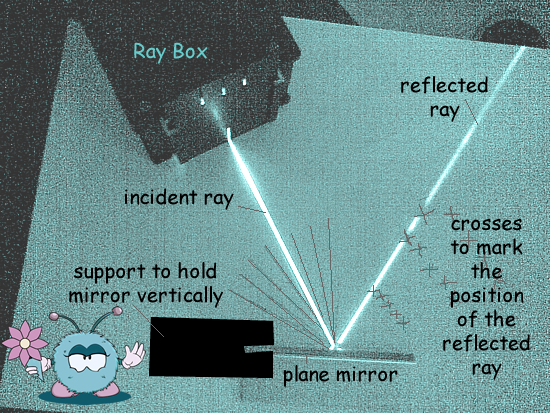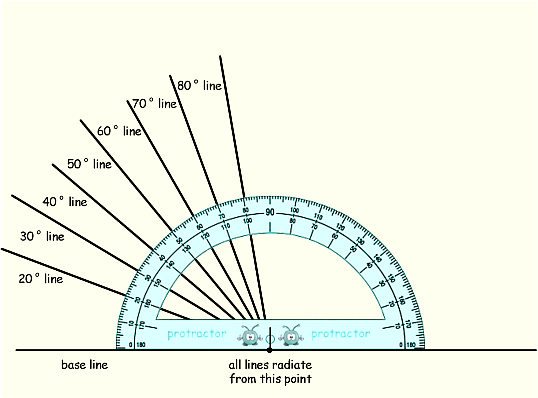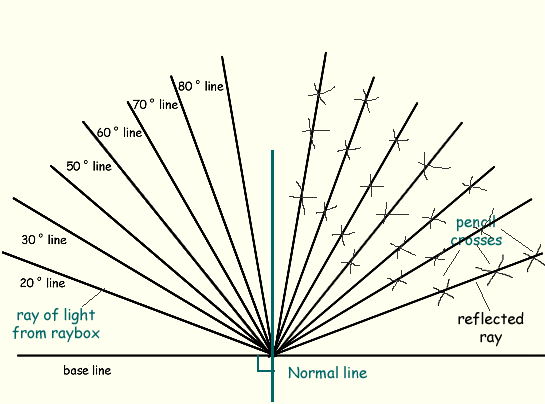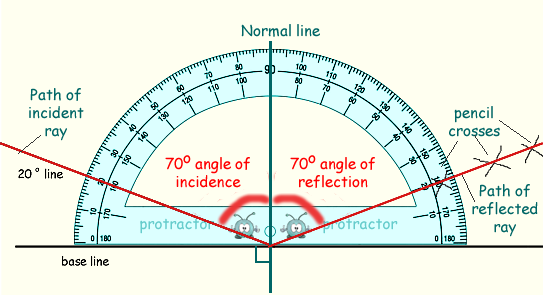To Investigate the Law of Reflection

 Take a sheet of paper and draw a set of lines coming from a point at the centre of it using a protractor and a ruler as shown below.
Take a sheet of paper and draw a set of lines coming from a point at the centre of it using a protractor and a ruler as shown below.

 Support a plane mirror so that its reflecting surface is perpendicular to your sheet of paper. Remove the protractor and place the mirror so that its reflecting side follows your base line, with its centre approximately where the lines radiate from.
Support a plane mirror so that its reflecting surface is perpendicular to your sheet of paper. Remove the protractor and place the mirror so that its reflecting side follows your base line, with its centre approximately where the lines radiate from.
 Guide the ray from a ray box along the 20o line.
Guide the ray from a ray box along the 20o line.
 Mark the position of the reflected ray with three pencil crosses. (Use three so that when you come to join them up, and show the path of the reflected ray, you will be able to tell how accurately you have marked the ray's position - You can always join two crosses with a line - but three will only be joined if they are truly in a straight line).
Mark the position of the reflected ray with three pencil crosses. (Use three so that when you come to join them up, and show the path of the reflected ray, you will be able to tell how accurately you have marked the ray's position - You can always join two crosses with a line - but three will only be joined if they are truly in a straight line).

 Repeat for each of the ray positions you have marked on your sheet of paper.
Repeat for each of the ray positions you have marked on your sheet of paper.
 Remove the sheet of paper from the experiment and carefully join up your crosses and extend the line of the reflected ray's path to the position of the mirror on the base line.
Remove the sheet of paper from the experiment and carefully join up your crosses and extend the line of the reflected ray's path to the position of the mirror on the base line.
 Construct a normal to the base line at the point where reflection occurred.
Construct a normal to the base line at the point where reflection occurred.

 Measure the angle of incidence from the normal to the position of the incident ray for each of the rays you investigated. Put your results in a table.
Measure the angle of incidence from the normal to the position of the incident ray for each of the rays you investigated. Put your results in a table.
 Measure the angle of reflection from the normal to the position of the reflected ray for each of the rays you investigated. Put your results in a table.
Measure the angle of reflection from the normal to the position of the reflected ray for each of the rays you investigated. Put your results in a table.

 You should find that the angle of incidence equals the angle of reflection for all of the rays you have investigated.
You should find that the angle of incidence equals the angle of reflection for all of the rays you have investigated.


